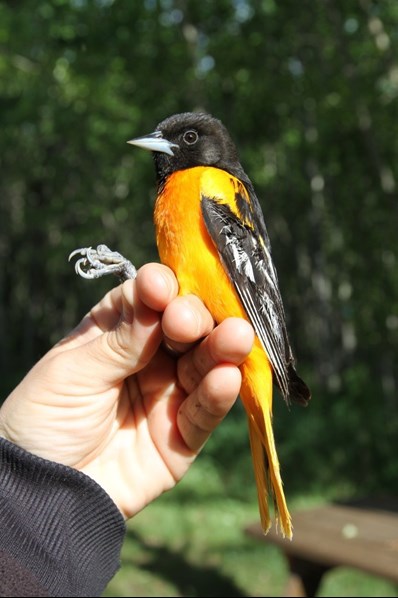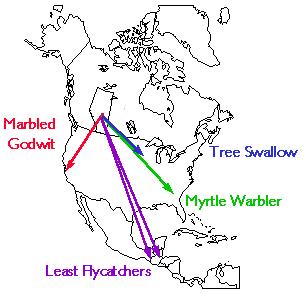Band Recoveries
BBO’s longest distance recovery and first in South America!
- An after second year, male Baltimore Oriole was banded by Sara Pearce Meijerink at the BBO on May 26th, 2017
- Flew over 5800 km before dying on October 22nd, 2017 after hitting a window in Sevillano, Colombia, approximately 10 km south of the Caribbean sea!
- Window strikes are one of the leading causes of bird mortality. You can take individual action to reduce bird mortality, check out our webpage “Help Protect Birds”
- Read the full story here


Two least flycatchers banded at the BBO and recovered in Guatemala give clues to their migratory route
First recovery:
- Banded by Jim Lange and Petra (Stubbs) Rowell at Beaverhill Lake on August 13, 1989
- Recovered in 1991 near Chiquimula, close to the Honduras border after being killed by a boy with a slingshot
Second recovery:
- Banded on July 19, 1993 by Josh Bilyk and Jason Duxbury at the BBO
- Recovered on October 9, 1996 north-west of Huehuetenango, Guatemala, near the border of Mexico weighing 10.8g.
Least flycatcher facts:
- Smallest Canadian representative of the genus Empidonax, weighing between 8 and 13 grams (about the mass of two cloves of garlic).
- Bands used on least flycatchers are only 5mm wide. The recovery of bands this small is rare (Jungkind 1990).
- Breeding range is from coast to coast and from the Yukon Territory south to Georgia (Briskie 1994).
- In winter, they migrate to central Mexico and can reach as far south as Panama (American Ornithological Union 1975, Briskie 1994)
Implications of these recaptures:
The second banded bird was recovered in the Sierra Madres Mountains, south-west of the Sierra Los Cuchumatanes range. Although the Sierra Los Cuchumatanes mountains block the way to the Gulf of Mexico from this location, nearby is the Selegua River, which eventually drains into the Gulf.
Birds following the gulf coast of Mexico or travelling across the gulf would have the option of following this river system, entering Central America without crossing any mountain ranges. Data like this, combined with other recaptures of migrating birds, is important for building understanding of the migratory habits of birds like the least flycatcher.
BBO relations in Guatemala
An American Peace Corps volunteer who reported the band helped start relationships with local conservation groups that allowed BBO personnel to travel to Guatemala and survey birds from 1993 to 1995. The results of those surveys helped rewrite outdated range maps and document new records for both migrant and resident birds (Dowell et al. unpublished data 1994). All this due to a tiny bird that flew over 4500km after being banded at the BBO.
Other notable recoveries of BBO banded birds
- Marbled Godwit (Limosa fedoa) found in California
- Tree Swallow (Tachycineta bicolor) found in Minnesota
- Myrtle Warbler (Dendroica coronata) found in Georgia
- Mourning Warbler (Orporonis philadelphia) recovered in Manitoba 11 days after it was banded.

Literature Cited:America Ornithological Union. 1975. Check-list of North American Birds, 5th Edition. Port City Press, Inc., Baltimore, Maryland. Briskie, J.V. 1994. Least Flycatcher (Empidonax minimus). In The Birds of North America, No. 99 (A. Poole and F. Gill, Eds.). Philadelphia: The Academy of Natural Science; Washington, D.C.: The American Ornithologists' Union. Dowell, B.A., G.L. Holroyd, C.S. Robbins. Bird habitat survey of Cerro San Gil and Polochic Delta, Guatemala. Technical Report, United States Biological Survey, Maryland. Jungkind, S. 1990. Beaverhill Bird Observatory Ten Year Summary Report (1980-89). Beaverhill Bird Observatory.

